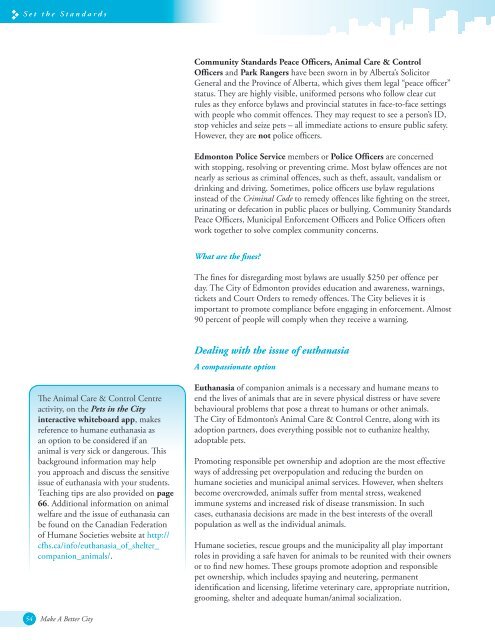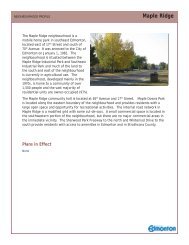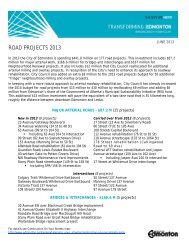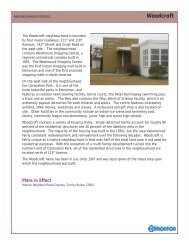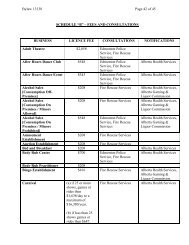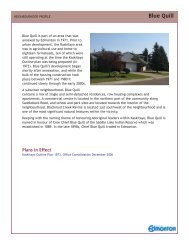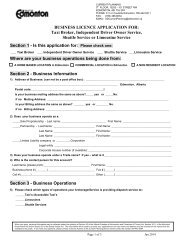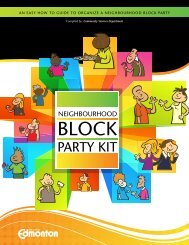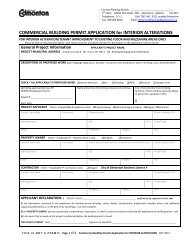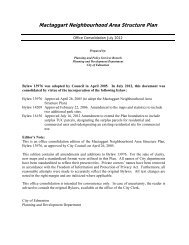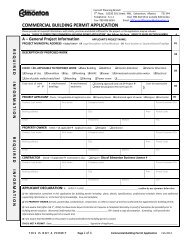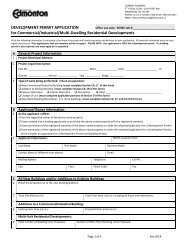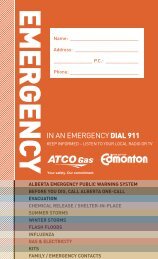Full Resource - City of Edmonton
Full Resource - City of Edmonton
Full Resource - City of Edmonton
Create successful ePaper yourself
Turn your PDF publications into a flip-book with our unique Google optimized e-Paper software.
Set the Standards<br />
Community Standards Peace Officers, Animal Care & Control<br />
Officers and Park Rangers have been sworn in by Alberta’s Solicitor<br />
General and the Province <strong>of</strong> Alberta, which gives them legal “peace <strong>of</strong>ficer”<br />
status. They are highly visible, uniformed persons who follow clear cut<br />
rules as they enforce bylaws and provincial statutes in face-to-face settings<br />
with people who commit <strong>of</strong>fences. They may request to see a person’s ID,<br />
stop vehicles and seize pets – all immediate actions to ensure public safety.<br />
However, they are not police <strong>of</strong>ficers.<br />
<strong>Edmonton</strong> Police Service members or Police Officers are concerned<br />
with stopping, resolving or preventing crime. Most bylaw <strong>of</strong>fences are not<br />
nearly as serious as criminal <strong>of</strong>fences, such as theft, assault, vandalism or<br />
drinking and driving. Sometimes, police <strong>of</strong>ficers use bylaw regulations<br />
instead <strong>of</strong> the Criminal Code to remedy <strong>of</strong>fences like fighting on the street,<br />
urinating or defecation in public places or bullying. Community Standards<br />
Peace Officers, Municipal Enforcement Officers and Police Officers <strong>of</strong>ten<br />
work together to solve complex community concerns.<br />
What are the fines<br />
The fines for disregarding most bylaws are usually $250 per <strong>of</strong>fence per<br />
day. The <strong>City</strong> <strong>of</strong> <strong>Edmonton</strong> provides education and awareness, warnings,<br />
tickets and Court Orders to remedy <strong>of</strong>fences. The <strong>City</strong> believes it is<br />
important to promote compliance before engaging in enforcement. Almost<br />
90 percent <strong>of</strong> people will comply when they receive a warning.<br />
Dealing with the issue <strong>of</strong> euthanasia<br />
A compassionate option<br />
The Animal Care & Control Centre<br />
activity, on the Pets in the <strong>City</strong><br />
interactive whiteboard app, makes<br />
reference to humane euthanasia as<br />
an option to be considered if an<br />
animal is very sick or dangerous. This<br />
background information may help<br />
you approach and discuss the sensitive<br />
issue <strong>of</strong> euthanasia with your students.<br />
Teaching tips are also provided on page<br />
66. Additional information on animal<br />
welfare and the issue <strong>of</strong> euthanasia can<br />
be found on the Canadian Federation<br />
<strong>of</strong> Humane Societies website at http://<br />
cfhs.ca/info/euthanasia_<strong>of</strong>_shelter_<br />
companion_animals/.<br />
Euthanasia <strong>of</strong> companion animals is a necessary and humane means to<br />
end the lives <strong>of</strong> animals that are in severe physical distress or have severe<br />
behavioural problems that pose a threat to humans or other animals.<br />
The <strong>City</strong> <strong>of</strong> <strong>Edmonton</strong>’s Animal Care & Control Centre, along with its<br />
adoption partners, does everything possible not to euthanize healthy,<br />
adoptable pets.<br />
Promoting responsible pet ownership and adoption are the most effective<br />
ways <strong>of</strong> addressing pet overpopulation and reducing the burden on<br />
humane societies and municipal animal services. However, when shelters<br />
become overcrowded, animals suffer from mental stress, weakened<br />
immune systems and increased risk <strong>of</strong> disease transmission. In such<br />
cases, euthanasia decisions are made in the best interests <strong>of</strong> the overall<br />
population as well as the individual animals.<br />
Humane societies, rescue groups and the municipality all play important<br />
roles in providing a safe haven for animals to be reunited with their owners<br />
or to find new homes. These groups promote adoption and responsible<br />
pet ownership, which includes spaying and neutering, permanent<br />
identification and licensing, lifetime veterinary care, appropriate nutrition,<br />
grooming, shelter and adequate human/animal socialization.<br />
54<br />
Make A Better <strong>City</strong>


